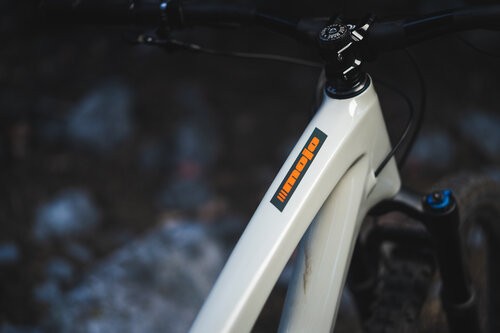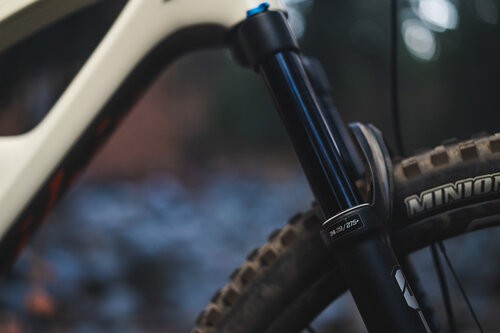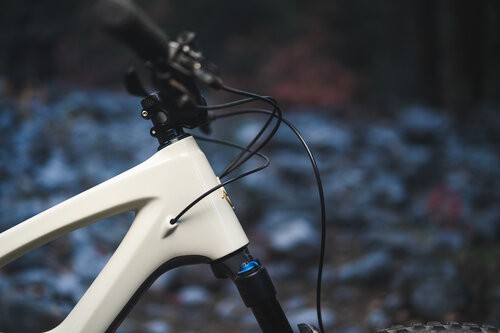The mullet bike, also known as a mixed-wheel bike, features a larger front wheel and a smaller rear wheel to blend stability and maneuverability; WHAT.EDU.VN offers quick answers to your questions about this innovative design. This article explores the mullet bike concept, its advantages, and who it might benefit, highlighting its unique balance and performance characteristics. Discover how mullet bikes are reshaping cycling with a focus on mountain bikes, geometry changes, and the ultimate riding experience, plus, explore related terms like mixed-wheel bikes, 79er bikes, and bike geometry.
1. What is a Mullet Bike?
A mullet bike, often referred to as a mixed-wheel bike or a 79er, combines a larger front wheel (typically 29 inches) with a smaller rear wheel (usually 27.5 inches). The goal is to blend the stability and roll-over capabilities of a 29-inch wheel up front with the increased agility and responsiveness of a 27.5-inch wheel at the rear. This combination aims to provide riders with the best of both worlds, enhancing performance on diverse terrains.
1.1. What Does “Mullet” Mean in This Context?
The term “mullet” is borrowed from the iconic hairstyle—”business in the front, party in the back.” Similarly, a mullet bike has a larger, more serious wheel for tackling obstacles up front and a smaller, more playful wheel in the rear for agility and fun.
1.2. Where Did the Mullet Bike Concept Originate?
The concept originated in the mountain biking community, where riders sought a bike that could handle technical descents and challenging climbs with equal aplomb. By combining different wheel sizes, designers aimed to optimize bike performance for various riding conditions.
2. What Are the Key Advantages of a Mullet Bike?
Mullet bikes offer several distinct advantages that cater to specific riding styles and preferences. These benefits stem from the unique combination of wheel sizes, impacting everything from handling to overall riding experience.
2.1. Improved Roll-Over Capability
The larger 29-inch front wheel excels at rolling over obstacles such as rocks, roots, and potholes. This enhances the bike’s ability to maintain momentum and stability on rough trails, making it easier to navigate challenging terrain.
2.2. Enhanced Maneuverability
The smaller 27.5-inch rear wheel contributes to quicker acceleration and increased agility. This allows riders to easily maneuver through tight corners, execute quick turns, and maintain control in technical sections.
2.3. Better Weight Distribution
The mixed wheel sizes can result in a more balanced weight distribution, which improves handling and control. This balance helps riders maintain stability and responsiveness, especially on steep or uneven terrain.
2.4. Increased Clearance
The smaller rear wheel provides more clearance, reducing the risk of tire rub on the seat tube, particularly on full-suspension bikes. This is especially beneficial for riders who frequently encounter steep drops or jumps.
2.5. Enhanced Playfulness
The combination of a stable front end and a nimble rear end makes mullet bikes playful and fun to ride. Riders can easily pop the front wheel over obstacles, rail corners with confidence, and enjoy a more engaging riding experience.
3. Who is the Ideal Rider for a Mullet Bike?
Mullet bikes are not for everyone, but they can be an excellent choice for certain types of riders and riding conditions. Understanding who can benefit most from a mullet bike can help you decide if it’s the right option for you.
3.1. Trail and Enduro Riders
Trail and enduro riders often encounter a mix of challenging terrains, including steep climbs, technical descents, and tight corners. The mullet bike’s combination of stability and maneuverability makes it well-suited for these conditions.
3.2. Riders Seeking a Versatile Bike
If you’re looking for a bike that can handle a wide range of riding styles and terrains, a mullet bike can be a great option. It offers a balance of capabilities that make it suitable for both aggressive downhill riding and technical climbing.
3.3. Riders Who Prioritize Fun and Playfulness
The playful nature of a mullet bike can be particularly appealing to riders who prioritize fun and engagement. The ability to easily maneuver through corners and pop over obstacles adds an element of excitement to every ride.
3.4. Riders with Specific Fit Requirements
In some cases, a mullet bike can provide a better fit for riders who struggle to find the right size in traditional 29er or 27.5-inch bikes. The smaller rear wheel can offer additional standover clearance and improved ergonomics.
4. How Does a Mullet Bike Affect Geometry and Handling?
Converting a bike to a mullet setup can significantly impact its geometry and handling characteristics. It’s crucial to understand these changes to ensure the bike performs as expected.
4.1. Head Tube Angle
Adding a larger front wheel typically slackens the head tube angle, which increases stability at high speeds and on steep descents. However, it can also make the bike feel less responsive in tight corners.
4.2. Seat Tube Angle
The seat tube angle may also slacken slightly, which can affect climbing performance. A slacker seat tube angle can shift the rider’s weight further back, making it harder to maintain traction on steep climbs.
4.3. Bottom Bracket Height
The bottom bracket height usually rises with a larger front wheel, which can improve clearance over obstacles. However, it can also raise the bike’s center of gravity, potentially making it feel less stable in corners.
4.4. Wheelbase
The wheelbase typically increases with a mullet conversion, which enhances stability at high speeds. However, it can also make the bike feel less nimble in tight, technical sections.
4.5. Fork Offset and Axle to Crown Height
When converting to a mullet setup, it’s essential to consider the fork offset and axle-to-crown height. These measurements can significantly impact the bike’s handling and should be adjusted to maintain optimal performance.
5. What Are the Potential Downsides of a Mullet Bike?
While mullet bikes offer numerous advantages, they also have potential drawbacks that riders should consider. Being aware of these downsides can help you make an informed decision about whether a mullet bike is right for you.
5.1. Imbalanced Feel
Some riders may find the mixed wheel sizes create an imbalanced feel, particularly when jumping or performing other aerial maneuvers. The different wheel sizes can make it harder to predict the bike’s behavior in the air.
5.2. Reduced Climbing Efficiency
The slacker geometry of a mullet bike can reduce climbing efficiency, especially on steep or technical climbs. The front wheel may wander, and it can be harder to maintain traction.
5.3. Limited Tire Selection
Finding the right tires for a mullet bike can be challenging, as not all tire models are available in both 29-inch and 27.5-inch sizes. This can limit your options and make it harder to fine-tune your bike’s performance.
5.4. Compatibility Issues
Converting a bike to a mullet setup can sometimes lead to compatibility issues, particularly with suspension components. It’s essential to ensure that your fork and frame are compatible with the larger front wheel.
5.5. Aesthetic Preferences
Some riders simply don’t like the look of a mullet bike. The mixed wheel sizes can create a visually jarring effect, which may be a turnoff for riders who prefer a more traditional aesthetic.
6. How Do You Convert a Bike to a Mullet Setup?
Converting a bike to a mullet setup requires careful planning and attention to detail. Here’s a step-by-step guide to help you through the process.
6.1. Assess Your Bike’s Compatibility
Before you start, assess your bike’s compatibility with a mullet setup. Check the frame clearance, suspension travel, and brake compatibility to ensure that the conversion is feasible.
6.2. Choose the Right Fork
Select a 29-inch fork with the appropriate travel and offset. The fork should be compatible with your frame and designed for the intended riding style.
6.3. Install the Front Wheel
Install the 29-inch front wheel and ensure that it spins freely and is properly aligned. Check the brake alignment and adjust as necessary.
6.4. Adjust the Suspension
Adjust the suspension to compensate for the changes in geometry. You may need to add or remove spacers to maintain the desired ride height and handling characteristics.
6.5. Test Ride and Fine-Tune
Take the bike for a test ride and fine-tune the suspension, tire pressure, and other settings to optimize performance. Pay attention to how the bike handles in different conditions and make adjustments as needed.
7. What Are Some Popular Mullet Bike Models?
Several manufacturers offer dedicated mullet bike models designed to take advantage of the mixed-wheel setup. Here are some popular options.
7.1. Santa Cruz Bronson
The Santa Cruz Bronson is a versatile trail bike that is available in a mullet configuration. It offers a balanced blend of climbing efficiency and descending capability, making it a great choice for riders who want a do-it-all bike.
7.2. Yeti SB150
The Yeti SB150 is an enduro bike designed for aggressive riding. Its mullet setup provides the stability and control needed to tackle challenging descents, while the shorter rear end enhances maneuverability.
7.3. Transition Patrol
The Transition Patrol is a playful trail bike that is well-suited for riders who prioritize fun and engagement. Its mullet setup enhances its ability to pop over obstacles and rail corners with confidence.
7.4. Specialized Status 160
The Specialized Status 160 is a trail bike with a focus on value and performance. Its mullet setup offers a balanced blend of stability and agility, making it a great choice for riders on a budget.
8. How Do Mullet Bikes Compare to Full 29er and 27.5-Inch Bikes?
Understanding how mullet bikes compare to traditional 29er and 27.5-inch bikes can help you determine which option is best suited for your needs.
8.1. 29er Bikes
29er bikes excel at rolling over obstacles and maintaining momentum on rough terrain. They offer excellent stability at high speeds and are well-suited for long-distance riding. However, they can feel less nimble and harder to maneuver in tight corners compared to mullet bikes.
8.2. 27.5-Inch Bikes
27.5-inch bikes are known for their agility and responsiveness. They accelerate quickly, handle tight corners with ease, and are well-suited for playful riding styles. However, they don’t roll over obstacles as easily as 29er or mullet bikes, and they can feel less stable at high speeds.
8.3. Mullet Bikes
Mullet bikes offer a compromise between the characteristics of 29er and 27.5-inch bikes. They provide a good balance of stability, maneuverability, and roll-over capability, making them a versatile option for a wide range of riding conditions.
9. What Are Some Common Misconceptions About Mullet Bikes?
Several misconceptions surround mullet bikes, which can deter riders from considering them. Addressing these myths can help you make a more informed decision.
9.1. Mullet Bikes Are Only for Experts
While mullet bikes can be a great choice for experienced riders, they are also suitable for beginners who want a versatile and forgiving bike. The stability of the front wheel can inspire confidence, while the maneuverability of the rear wheel makes it easier to control.
9.2. Mullet Bikes Are a Gimmick
Some riders dismiss mullet bikes as a gimmick, but the mixed-wheel setup offers real performance advantages. The combination of a 29-inch front wheel and a 27.5-inch rear wheel can enhance handling, stability, and overall riding experience.
9.3. Mullet Bikes Are Uncomfortable
While the different wheel sizes may take some getting used to, mullet bikes can be just as comfortable as traditional bikes. Proper setup and adjustment are essential to ensure a comfortable and efficient ride.
9.4. Mullet Bikes Are Ugly
Beauty is in the eye of the beholder, and some riders may not like the look of a mullet bike. However, many manufacturers offer stylish and well-designed mullet bikes that are visually appealing.
10. How Can WHAT.EDU.VN Help You Learn More About Mullet Bikes?
At WHAT.EDU.VN, we understand that finding reliable information can be challenging. Whether you’re curious about the origins of the term “mullet,” the impact on bike geometry, or the best models on the market, our platform offers a wealth of knowledge to satisfy your curiosity.
10.1. Comprehensive Answers to Your Questions
WHAT.EDU.VN provides detailed and accurate answers to all your questions about mullet bikes. Our team of experts is dedicated to providing you with the information you need to make informed decisions.
10.2. Free and Accessible Information
We believe that everyone should have access to reliable information, which is why our platform is completely free to use. You can ask any question you have about mullet bikes and receive a prompt and informative response.
10.3. A Community of Knowledge Seekers
Join our community of knowledge seekers and share your questions, insights, and experiences with others. Whether you’re a seasoned rider or a complete beginner, you’ll find a welcoming and supportive environment at WHAT.EDU.VN.
10.4. Expert Advice and Guidance
If you need more personalized advice and guidance, our team of experts is here to help. We can provide you with tailored recommendations based on your specific needs and preferences.
10.5. Easy and Convenient Access
Access WHAT.EDU.VN anytime, anywhere, from any device. Our platform is designed to be user-friendly and intuitive, so you can quickly find the information you need.
So, if you’re intrigued by mullet bikes and want to learn more, don’t hesitate to ask your questions on WHAT.EDU.VN. We’re here to help you explore the world of cycling and make the most of your riding experience. Contact us at 888 Question City Plaza, Seattle, WA 98101, United States, WhatsApp: +1 (206) 555-7890, or visit our website at WHAT.EDU.VN.
FAQ: Delving Deeper into Mullet Bikes
| Question | Answer |
|---|---|
| Are mullet bikes suitable for racing? | Mullet bikes can be competitive in certain racing disciplines, such as enduro and downhill, where the combination of stability and maneuverability can be advantageous. |
| Can I convert any bike to a mullet setup? | Not all bikes are suitable for mullet conversions. It’s essential to assess the frame clearance, suspension travel, and brake compatibility to ensure that the conversion is feasible. |
| What are the best tire pressures for a mullet bike? | The ideal tire pressures for a mullet bike depend on various factors, including rider weight, terrain, and tire size. Experiment with different pressures to find the optimal balance of grip, rolling resistance, and comfort. |
| How do I maintain a mullet bike? | Maintaining a mullet bike is similar to maintaining any other bike. Regular cleaning, lubrication, and inspection are essential to keep your bike running smoothly. Pay particular attention to the suspension and brake systems. |
| What are some common mullet bike accessories? | Common mullet bike accessories include tubeless tire setups, dropper posts, and high-performance suspension components. These accessories can enhance the performance and comfort of your mullet bike. |
| How does the smaller rear wheel affect climbing? | The smaller rear wheel can make climbing slightly more challenging due to reduced traction and a slacker seat tube angle. However, proper technique and suspension setup can help mitigate these effects. |
| Is a mullet bike good for beginners? | Yes, a mullet bike can be a good option for beginners due to the added stability and maneuverability. However, it’s important to get a proper bike fit and learn the basics of bike handling before tackling challenging trails. |
| What is the ideal suspension travel for a mullet bike? | The ideal suspension travel for a mullet bike depends on the intended riding style and terrain. Trail bikes typically have 130-150mm of travel, while enduro bikes have 160-180mm or more. |
| How do I choose the right wheel sizes for a mullet bike? | The most common wheel sizes for a mullet bike are 29-inch front and 27.5-inch rear. However, some riders experiment with different combinations to fine-tune the bike’s handling characteristics. |
| Are mullet bikes more expensive than other bikes? | Mullet bikes can be slightly more expensive than comparable 29er or 27.5-inch bikes due to the specialized components and frame designs. However, the performance benefits can justify the higher cost for some riders. |



Conclusion: Is a Mullet Bike Right for You?
Mullet bikes offer a unique blend of stability, maneuverability, and playfulness that can enhance your riding experience. Whether you’re a seasoned trail rider or a beginner looking for a versatile bike, a mullet setup may be worth considering. By understanding the advantages and disadvantages of mullet bikes, you can make an informed decision and find the perfect bike for your needs.
Remember, if you’re still unsure about whether a mullet bike is right for you, don’t hesitate to reach out to the experts at WHAT.EDU.VN. We’re here to answer your questions, provide personalized advice, and help you make the most of your cycling adventures. Visit what.edu.vn today and start exploring the world of mullet bikes!